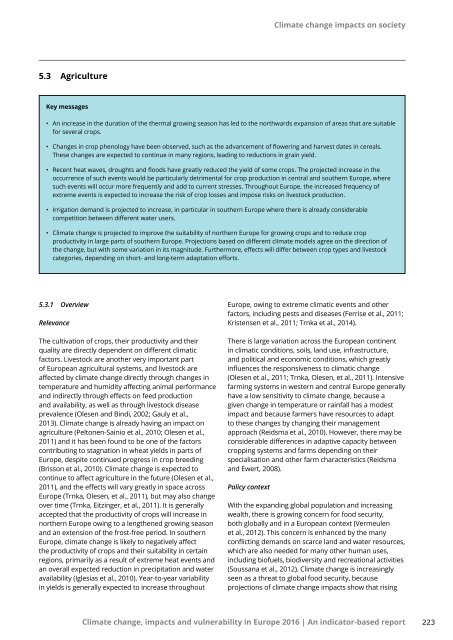Climate change impacts and vulnerability in Europe 2016
document
document
Create successful ePaper yourself
Turn your PDF publications into a flip-book with our unique Google optimized e-Paper software.
<strong>Climate</strong> <strong>change</strong> <strong>impacts</strong> on society<br />
5.3 Agriculture<br />
Key messages<br />
• An <strong>in</strong>crease <strong>in</strong> the duration of the thermal grow<strong>in</strong>g season has led to the northwards expansion of areas that are suitable<br />
for several crops.<br />
• Changes <strong>in</strong> crop phenology have been observed, such as the advancement of flower<strong>in</strong>g <strong>and</strong> harvest dates <strong>in</strong> cereals.<br />
These <strong>change</strong>s are expected to cont<strong>in</strong>ue <strong>in</strong> many regions, lead<strong>in</strong>g to reductions <strong>in</strong> gra<strong>in</strong> yield.<br />
• Recent heat waves, droughts <strong>and</strong> floods have greatly reduced the yield of some crops. The projected <strong>in</strong>crease <strong>in</strong> the<br />
occurrence of such events would be particularly detrimental for crop production <strong>in</strong> central <strong>and</strong> southern <strong>Europe</strong>, where<br />
such events will occur more frequently <strong>and</strong> add to current stresses. Throughout <strong>Europe</strong>, the <strong>in</strong>creased frequency of<br />
extreme events is expected to <strong>in</strong>crease the risk of crop losses <strong>and</strong> impose risks on livestock production.<br />
• Irrigation dem<strong>and</strong> is projected to <strong>in</strong>crease, <strong>in</strong> particular <strong>in</strong> southern <strong>Europe</strong> where there is already considerable<br />
competition between different water users.<br />
• <strong>Climate</strong> <strong>change</strong> is projected to improve the suitability of northern <strong>Europe</strong> for grow<strong>in</strong>g crops <strong>and</strong> to reduce crop<br />
productivity <strong>in</strong> large parts of southern <strong>Europe</strong>. Projections based on different climate models agree on the direction of<br />
the <strong>change</strong>, but with some variation <strong>in</strong> its magnitude. Furthermore, effects will differ between crop types <strong>and</strong> livestock<br />
categories, depend<strong>in</strong>g on short- <strong>and</strong> long-term adaptation efforts.<br />
5.3.1 Overview<br />
Relevance<br />
The cultivation of crops, their productivity <strong>and</strong> their<br />
quality are directly dependent on different climatic<br />
factors. Livestock are another very important part<br />
of <strong>Europe</strong>an agricultural systems, <strong>and</strong> livestock are<br />
affected by climate <strong>change</strong> directly through <strong>change</strong>s <strong>in</strong><br />
temperature <strong>and</strong> humidity affect<strong>in</strong>g animal performance<br />
<strong>and</strong> <strong>in</strong>directly through effects on feed production<br />
<strong>and</strong> availability, as well as through livestock disease<br />
prevalence (Olesen <strong>and</strong> B<strong>in</strong>di, 2002; Gauly et al.,<br />
2013). <strong>Climate</strong> <strong>change</strong> is already hav<strong>in</strong>g an impact on<br />
agriculture (Peltonen-Sa<strong>in</strong>io et al., 2010; Olesen et al.,<br />
2011) <strong>and</strong> it has been found to be one of the factors<br />
contribut<strong>in</strong>g to stagnation <strong>in</strong> wheat yields <strong>in</strong> parts of<br />
<strong>Europe</strong>, despite cont<strong>in</strong>ued progress <strong>in</strong> crop breed<strong>in</strong>g<br />
(Brisson et al., 2010). <strong>Climate</strong> <strong>change</strong> is expected to<br />
cont<strong>in</strong>ue to affect agriculture <strong>in</strong> the future (Olesen et al.,<br />
2011), <strong>and</strong> the effects will vary greatly <strong>in</strong> space across<br />
<strong>Europe</strong> (Trnka, Olesen, et al., 2011), but may also <strong>change</strong><br />
over time (Trnka, Eitz<strong>in</strong>ger, et al., 2011). It is generally<br />
accepted that the productivity of crops will <strong>in</strong>crease <strong>in</strong><br />
northern <strong>Europe</strong> ow<strong>in</strong>g to a lengthened grow<strong>in</strong>g season<br />
<strong>and</strong> an extension of the frost-free period. In southern<br />
<strong>Europe</strong>, climate <strong>change</strong> is likely to negatively affect<br />
the productivity of crops <strong>and</strong> their suitability <strong>in</strong> certa<strong>in</strong><br />
regions, primarily as a result of extreme heat events <strong>and</strong><br />
an overall expected reduction <strong>in</strong> precipitation <strong>and</strong> water<br />
availability (Iglesias et al., 2010). Year-to-year variability<br />
<strong>in</strong> yields is generally expected to <strong>in</strong>crease throughout<br />
<strong>Europe</strong>, ow<strong>in</strong>g to extreme climatic events <strong>and</strong> other<br />
factors, <strong>in</strong>clud<strong>in</strong>g pests <strong>and</strong> diseases (Ferrise et al., 2011;<br />
Kristensen et al., 2011; Trnka et al., 2014).<br />
There is large variation across the <strong>Europe</strong>an cont<strong>in</strong>ent<br />
<strong>in</strong> climatic conditions, soils, l<strong>and</strong> use, <strong>in</strong>frastructure,<br />
<strong>and</strong> political <strong>and</strong> economic conditions, which greatly<br />
<strong>in</strong>fluences the responsiveness to climatic <strong>change</strong><br />
(Olesen et al., 2011; Trnka, Olesen, et al., 2011). Intensive<br />
farm<strong>in</strong>g systems <strong>in</strong> western <strong>and</strong> central <strong>Europe</strong> generally<br />
have a low sensitivity to climate <strong>change</strong>, because a<br />
given <strong>change</strong> <strong>in</strong> temperature or ra<strong>in</strong>fall has a modest<br />
impact <strong>and</strong> because farmers have resources to adapt<br />
to these <strong>change</strong>s by chang<strong>in</strong>g their management<br />
approach (Reidsma et al., 2010). However, there may be<br />
considerable differences <strong>in</strong> adaptive capacity between<br />
cropp<strong>in</strong>g systems <strong>and</strong> farms depend<strong>in</strong>g on their<br />
specialisation <strong>and</strong> other farm characteristics (Reidsma<br />
<strong>and</strong> Ewert, 2008).<br />
Policy context<br />
With the exp<strong>and</strong><strong>in</strong>g global population <strong>and</strong> <strong>in</strong>creas<strong>in</strong>g<br />
wealth, there is grow<strong>in</strong>g concern for food security,<br />
both globally <strong>and</strong> <strong>in</strong> a <strong>Europe</strong>an context (Vermeulen<br />
et al., 2012). This concern is enhanced by the many<br />
conflict<strong>in</strong>g dem<strong>and</strong>s on scarce l<strong>and</strong> <strong>and</strong> water resources,<br />
which are also needed for many other human uses,<br />
<strong>in</strong>clud<strong>in</strong>g biofuels, biodiversity <strong>and</strong> recreational activities<br />
(Soussana et al., 2012). <strong>Climate</strong> <strong>change</strong> is <strong>in</strong>creas<strong>in</strong>gly<br />
seen as a threat to global food security, because<br />
projections of climate <strong>change</strong> <strong>impacts</strong> show that ris<strong>in</strong>g<br />
<strong>Climate</strong> <strong>change</strong>, <strong>impacts</strong> <strong>and</strong> <strong>vulnerability</strong> <strong>in</strong> <strong>Europe</strong> <strong>2016</strong> | An <strong>in</strong>dicator-based report<br />
223


